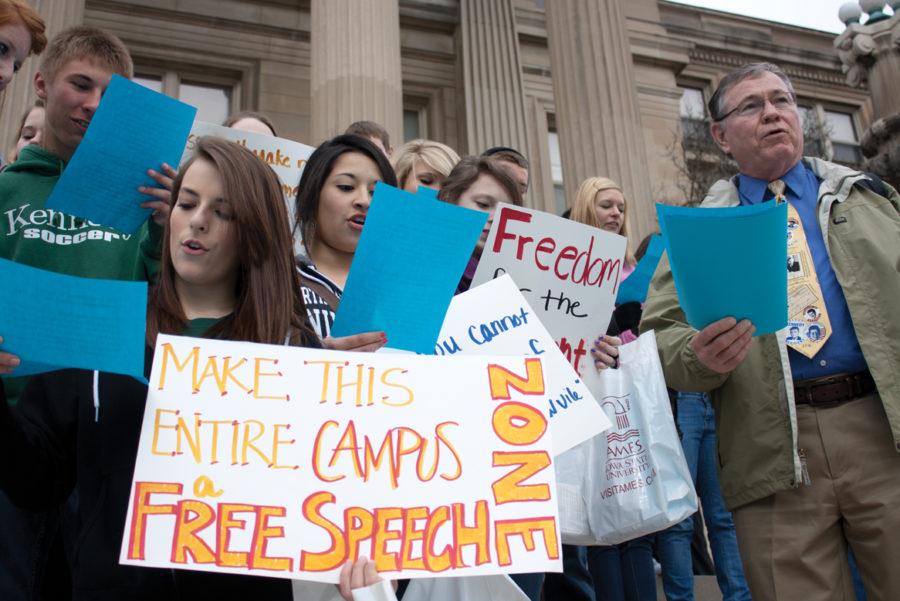Kremer: University policy should not be the only factor in determining speech code rating
Photo: Kelsey Kremer/Iowa State Daily
High School students and their adviser, Gary Lindsey, from John F. Kennedy High School in Cedar Rapids recite the First Amendment on the steps of Beardshear Hall after completing the First Amendment Day Freedom March on Thursday, April 7. Students from three different high schools came to Iowa State yesterday to celebrate First Amendment Day.
January 26, 2012
The Foundation for Individual Rights in Education recently released its yearly report on campus speech codes. FIRE reviewed the policy of 392 colleges and universities and gave each a red-, yellow- or green-light rating for First Amendment standards. Of the 392 schools, 65 percent of them received a red-light rating, including the University of Iowa, University of Northern Iowa and Iowa State. Only 14 schools received a green light for their speech code and school policy.
As president of the ISU chapter of the Society of Professional Journalists, I was asked to comment on the university’s red-light classification for a story in the Ames Tribune. This got me thinking about speech codes on our campus and how they are perceived.
FIRE looks specifically at university harassment policies, free-speech zone policies, Internet usage policies and advertised commitments to free expression.
Iowa State received a green light for recognizing the constitutional right of students in the student disciplinary regulations policy.
A yellow light was received for the code of computer ethics and acceptable use policy, which prohibits the sending of unsolicited emails without approval and harassment via electronic means. A yellow light was also given for the facilities and ground use policy for defining the area allowed for public forum and requiring a notice of intent to use the area under certain circumstances.
The red-light rating comes from the harassment policies at Iowa State. According to FIRE, this is the policy that is most commonly abused for regulations that are too broad. According to a post on FIRE’s website, Iowa State “policies explicitly reserve the right to punish protected speech.”
I don’t think the strength of the First Amendment on a college campus comes from policy. It’s found in the attitudes of the faculty and students who exercise those rights on campus.
According to the First Amendment Center’s 2011 State of the First Amendment survey, 30 percent of Americans cannot list any of the rights guaranteed by the First Amendment. Before coming to Iowa State, I did not know about those constitutional protections and how they relate to public policy. Now, as I sit in the Iowa State Daily newsroom writing this, the five freedoms hang on the wall behind me. I learned the First Amendment in my journalism classes and I know that I am free to express myself at Iowa State.
Iowa State has a tradition of honoring the First Amendment, teaching it in classes, exercising it in many student publications and organizations across campus and celebrating it each year on First Amendment Day.
In the past year, I have observed students gathered on campus to celebrate the death of Osama bin Laden, to protest the observance of Columbus Day and to march in solidarity with Occupy Wall Street protesters. None of this could take place if students did not feel they had the right to express themselves on Iowa State’s campus. We have seven student publications, a television station and a radio station, and students from all across the university express themselves through these mediums every day.
I believe ISU students and faculty feel they can express themselves at Iowa State despite the red-light rating given by FIRE. That does not mean the red-light rating should be ignored. I think my friend and past president of SPJ Jessie Opoien said it best in an email to First Amendment Day committee members last week regarding the red-light rating.
“A red-light rating should energize the First Amendment Day committee, not deflate us. It makes what we do that much more important,” Opoien said. “We should use this as a tool to draw more attention to our efforts and try to get even more students, faculty and staff involved.”
This year is the 10th anniversary of First Amendment Day at Iowa State, which I think is a great platform to encourage university leaders to look at the policies that chill free speech on campus and work toward a green-light rating in all categories. I would love to see the red-light ranking and university policy changed to reflect how the First Amendment is embodied on campus, but despite that, I also encourage students to keep celebrating the First Amendment at Iowa State. Submit something to the Daily, join a new club, occupy, go to church — or not. Stop keeping your opinion to yourself and, most importantly, express yourself.

















